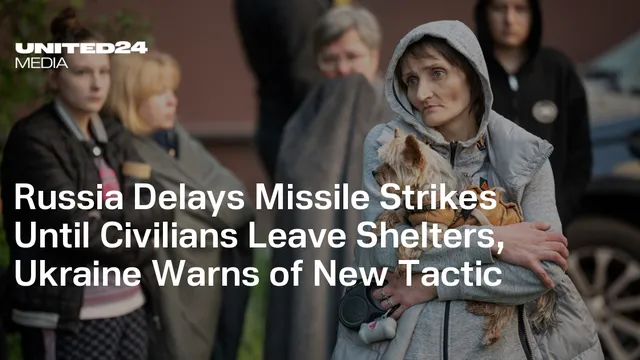
Russia uses deadly delayed attack tactic on civilians in Ukraine
2025-06-26 00:00- Russian troops are implementing a 'delayed attack' strategy, launching drones to force civilians into shelters before following up with missiles.
- Casualties from Russian drone and missile strikes are escalating, with recent attacks resulting in multiple deaths and injuries.
- This new tactic poses a heightened risk to civilians, prompting calls for urgent action and reassessment of military strategies.
Express your sentiment!
Insights
In Ukraine, as the conflict with Russian forces continues to escalate, new tactics have emerged that pose significant risks to civilians. Interior Minister Ihor Klymenko reported on June 23 that Russian troops have adopted a 'delayed attack' strategy. This involves launching drones in the evening, which prompts residents to take shelter. After several hours, when the danger seems to have passed, missiles are then fired, often around dawn as people return to their homes. This alarming tactic has reportedly resulted in numerous civilian casualties, including a recent incident in Bila Tserkva that left several injured. On June 25, the violence escalated further with Russian drone strikes in the Kherson province, claiming the lives of three residents and injuring thirteen others. This follows a previous ballistic missile strike in Dnipropetrovsk, which has raised the death toll to twenty, highlighting the intensifying toll of the ongoing conflict. Ukrainian forces have also been fighting back; on the same day, they successfully destroyed a Russian ship that was part of the Black Sea Fleet. The ship was allegedly moving troops along the coast, attempting to establish control in the region. The international response to these events continues to evolve, with discussions during a June 25 summit in The Hague focusing on military and financial support for Ukraine. While Western nations acknowledge the need to provide aid for Ukraine's defense, rising security concerns and political instability have affected private investment in the region, stalling economic recovery efforts. Key developments, such as the signed agreement with the US for the development of Ukraine’s mineral resources, potentially offer a glimmer of hope, though significant results are still years away. Amid these military and economic struggles, the Ukrainian government remains resilient. However, the relentless violence and civilian casualties underscore the increasingly desperate situation. As Ukraine approaches its 1,219th day of conflict, the risk to civilians remains a pressing concern, prompting urgent calls for a reassessment of military tactics by both sides to prevent further loss of innocent lives.
Contexts
The history of Russian military strategies in Ukraine has evolved significantly over the past few decades, reflecting broader geopolitical interests and complex historical ties between the two nations. The tension escalated dramatically after Ukraine's independence from the Soviet Union in 1991, as Russia perceived any move toward Western alignment by Ukraine as a threat to its influence in the region. Military strategies were initially characterized by a focus on maintaining a strong posture along its borders, with a combination of traditional military force deployment and hybrid warfare tactics aimed at undermining Ukrainian sovereignty without direct engagement. This included the use of propaganda, cyber warfare, and support for separatist movements in Eastern Ukraine, particularly in the Donetsk and Luhansk regions, which began notably in 2014 following the Euromaidan protests and the annexation of Crimea by Russia. In the subsequent years, from 2014 onwards, Russia's military strategy further shifted towards the concept of asymmetric warfare, leveraging irregular forces and deniable operations to achieve strategic objectives while minimizing direct confrontation with NATO and Western forces. This strategy was partially a response to international sanctions and increasing military aid to Ukraine from Western allies. Russian military doctrine began to emphasize rapid deployment and the integration of non-military means in warfare, assessing the utility of using regional proxies and irregular units to pursue its goals while maintaining plausible deniability. The hybrid warfare model allowed Russia to exploit divisions within Ukrainian society and capitalized on the historical grievances that still resonate in the region. In recent times, particularly from 2022, the conflict intensified, leading to a perceived shift in Russian military strategy towards a more conventional approach, with large-scale mobilization of troops and resources aimed at full-scale domination of Ukraine rather than just supporting separatist movements. The introduction of advanced military technologies and significant troop mobilizations indicated a strategic recalibration to confront the Western military aid and support being given to Ukraine. Russian military planners aimed to dominate key urban centers and infrastructure while utilizing air power to weaken Ukrainian defense capabilities. This evident pivot demonstrated Russia's willingness to escalate its military approach, aligning with broader objectives of reasserting its influence in former Soviet states and resisting NATO expansion. The strategic landscape continues to be shaped by external factors, including the responses from NATO and the European Union, which have provided critical support to Ukraine both in terms of military supplies and economic assistance. Russia's military strategy in Ukraine serves as a focal point for examining its broader objectives in Eastern Europe and its aspirations to reestablish dominance over areas it previously controlled. As the conflict evolves, understanding the intricacies of these military strategies will be essential for policymakers, military analysts, and historians alike, as they navigate the complex dynamics of military conflict in a rapidly changing geopolitical landscape.